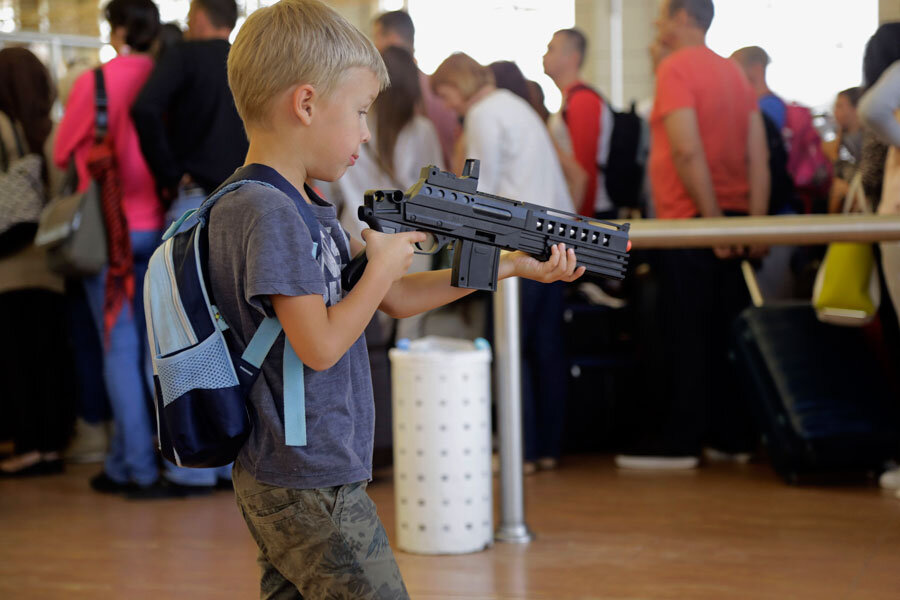Man with toy gun killed by Baltimore cop. Should toy guns be illegal?
Loading...
An off-duty Baltimore policeman on Saturday shot and killed a man he says appeared to be holding him at gunpoint in the suburbs of Linthicum Heights.
But when Anne Arudnel County detectives surveyed the crime scene, they realized the would-be robber was wielding a toy gun.
“It appears that this is a robbery gone wrong and the officer fired in self-defense,” Anne Arundel Police Lt. Ryan Frashure told WJZ News. “No officer wants to kill anybody much less use his service weapon if he doesn’t have to. This was just an unfortunate series of events.”
And the officer was getting out of his vehicle just before 2 a.m. Saturday, Moreland approached him and pointed what appeared to be a handgun at the officer, asking for his wallet. Because he had just finished his shift, the officer was not in uniform.
Officials say detectives found several pieces of evidence to back-up the officer’s story.
“One of those pieces of evidence was a toy gun that was very realistic, looked like a black revolver, that’s believed to be what the suspect pointed at the officer,” Frashure told WBAL TV.
Police say Moreland was homeless at the time and he had previously pleaded guilty to assault in 2011 and drug-related charges.
“We feel very bad for the Moreland family to deal with the loss of a son especially around the holidays,” Lt. Frashure said in a statement. “I’m sorry, our condolences to the family. Our condolences to the Baltimore city officer. It’s a very unfortunate incident to be placed into.”
An unfortunate incident that many say could have been avoided.
While gun laws in the US have the center of national debate in 2015, many cities and states have taken action to ban realistic-looking toy guns.
In November, Mayor Marty Walsh of Boston passed a new law banning realistic-looking toy handguns in public places. Boston officials say in light of rampant gun violence in the US, the threat of toy guns should be taken off the table.
“No one, especially a police officer who has the burden of making a split second decision, should ever have to guess if a gun is real,” said State Representative Dan Cullinane in a press release. Boston police officers have already confiscated 150 replica handguns this year, the statement reports.
“Replica guns have become a big issue for us,” said Commissioner William B. Evans in a press release. “We all too often encounter young people who are carrying these fake guns and even though they are fake, the public and police don’t know they are.”
One of these “young people” is 12-year-old Tamir Rice, who was shot and killed last year by police in Cleveland after brandishing what turned out to be a pellet gun.
Chicago and New York City are also leading the way in the ban against gun replicas. Not only is it illegal to wield a toy gun in public in Chicago – if a toy gun is used to commit a crime in the city the perpetrator is treated as if they used a real firearm.
In New York City, toy guns can’t be sold unless they are brightly colored. The city’s law has led to over 7,200 toy gun seizures and $2.4 million in fines. In August, five online retailers including Amazon and Walmart agreed to stop shipping realistic-looking guns to New York and paying more than $309,000 in fines to the state, collectively.
New York state attorney general Eric Schneiderman says there have been 63 shootings linked to toy guns in the state since 1994, resulting in at least eight deaths.
Some gun-control advocates have pointed to these rules as proof that real guns should be subjected to the same scrutiny as replicas. In Dallas, for example, fake guns have been illegal in public places like restaurants and shops since 2007, but carrying real guns in the same establishments is still legal. And in Chicago, Boston, and New York City, the same cities with model fake gun laws, residents with the proper licensing are allowed to carry concealed firearms in public.
While a national law from 1989 requires all fake guns to have an orange safety cap, some say that’s not enough.
Some children remove the caps to make their guns look more realistic. In some cases, the orange caps are too small for officers to notice. In a federal funded experiment in 1989, Virginia and Maryland police were confronted by actors holding both real firearms and orange-capped toy guns. Ninety-six percent of officers fired at the toy guns, as the orange cap “completely failed to enable the test subjects to identify the weapon as a toy,” the study concluded.
In the case of 12-year-old Tamir Rice, the orange safety cap had been removed.








